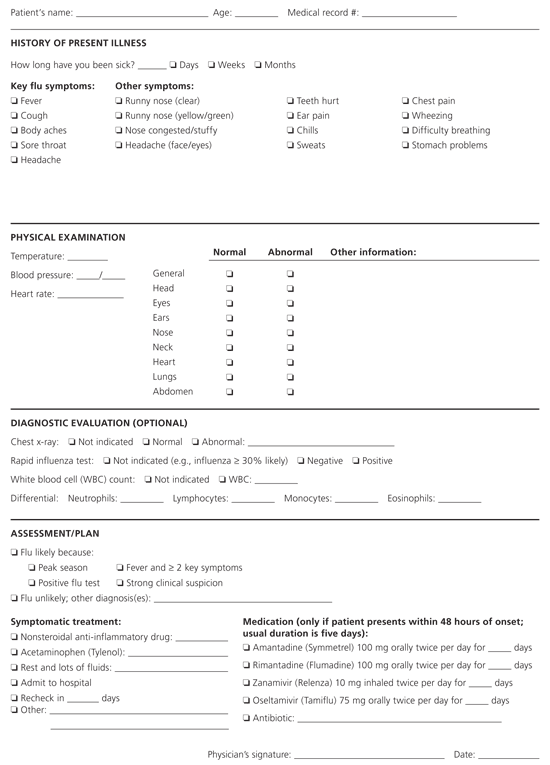
Am Fam Physician. 2005;72(9):1789-1792
Clinical Question
What is the best approach to diagnosing and treating a patient with suspected influenza?
Evidence Summary
During the winter months, influenza is one of the most common illnesses among patients of primary care physicians, with as many as one in five adults infected each year.1 The typical patient presents with a sudden onset of symptoms (fever, nonproductive cough, myalgias, headache, coryza, and/or sore throat).2 Clinical diagnosis of influenza is challenging, however, because these symptoms are shared with many other common respiratory tract infections. The prevalence of influenza is an important factor to consider. Prevalence varies from less than 3 percent among patients with febrile respiratory illness before or after the influenza season, to approximately 5 to 10 percent during the early and late influenza season (“shoulder” season), to 30 percent or more during the peak of influenza season.3–6 The proportion of patients with influenza A versus influenza B varies each year, as does the seasonal peak. For example, in the 2004–2005 flu season, the peak occurred in mid-February; 27 percent of patients with suspected influenza were diagnosed with the illness, and approximately one third of these patients had influenza B. During the 2003–2004 flu season, however, the peak occurred in mid-December, and although 35 percent of patients with suspected influenza were diagnosed with the disease, only 1 percent had influenza B.6
Two recent meta-analyses2,4 reviewed the evidence regarding clinical diagnosis of influenza. Both showed that fever, cough, rigors, and sweats increased the likelihood of influenza, but that these symptoms individually had a relatively poor predictive value. Clinical decision rules that combine groups of symptoms have not been developed or validated. The largest study to date5 of influenza diagnosis enrolled 3,744 patients during fall and winter; 68 percent of participants were diagnosed with influenza using culture, immunofluorescence, serology, or polymerase chain reaction tests. Only patients with fever and two or more key symptoms (headache, myalgias, cough, or sore throat) were included in the study. These inclusion criteria5 can therefore serve as an informal clinical prediction rule for identifying patients with suspected influenza during winter months.
Only one study7 examined white blood cell (WBC) counts for diagnosing influenza. Given a 50 percent overall probability of influenza among patients with suspected influenza (typical of peak flu season), a WBC count of 4,000 per mm3 (4×109 per L) or less increased the likelihood of influenza to 76 percent, whereas a count above this cutoff decreased the likelihood to 46 percent. Other cutoff points for WBC count did not increase the likelihood of influenza to a clinically significant degree. Therefore, the WBC count is only helpful when it is 4,000 per mm3 or less, and the WBC count cannot be recommended for routine influenza evaluation because of its cost and inconvenience.
Two cost-effectiveness analyses3,8 supported empiric treatment with antiviral agents for appropriate patients if the likelihood of influenza is high. The first study3 recommended empiric oseltamivir (Tami-flu) therapy for all patients during a regional epidemic when the probability of influenza is over 70 percent, for high-risk patients during the shoulder and peak of influenza season, and for intermediate-risk patients during the peak of the season. Use of a rapid test only was recommended for low-risk, vaccinated patients during the peak of influenza season; and for intermediate-risk, vaccinated patients and low-risk, unvaccinated patients when the overall risk of influenza is low. A second analysis8 supported empiric treatment with amantadine (Symmetrel), rimantadine (Flumadine), or oseltamivir when the likelihood of influenza is high. Rapid testing was only recommended if the likelihood of influenza is less than 30 percent. Table 13,6 shows the predictive value of rapid testing at different times of the year.
| Time of year | Probability of influenza (%) | ||
|---|---|---|---|
| Pretest | Negative rapid test* | Positive rapid test* | |
| Not influenza season | 2 | < 1 | 27 |
| Shoulder of influenza season | 5 to 10 | 1 to 3 | 49 to 67 |
| Influenza season | 30 to 50 | 11 to 22 | 89 to 95 |
The Centers for Disease Control and Prevention (CDC) releases annual guidelines for the prevention of influenza and the appropriate use of antiviral agents. The guidelines do not include specific criteria for when to use rapid tests and when to treat empirically, although they point out that the prevalence of influenza in the specific community is critical to that decision. The most current CDC data are available online at http://www.cdc.gov/flu/weekly/fluactivity.htm. When surveillance data show that the risk of influenza B is low, amantadine and rimantadine are effective and less expensive alternatives to the neuraminidase inhibitors zanamivir (Relenza) and oseltamivir.
Physicians should remember that antiviral therapies have limits. Patients only benefit if treated within 48 hours of onset; patients do not benefit if treated later, and only costs and adverse effects result. The benefit of antiviral therapy within 48 hours is modest, giving the patient an average of one less day of symptoms. The benefit is somewhat greater if the patient is treated within 30 hours, giving the patient approximately two less days of symptoms.9,10 Key information about prescribing antiviral drugs is summarized in Table 2.
Patients with suspected bacterial superinfection should be treated with a betalactam or respiratory fluoroquinolone antibiotic.11
| Drug | Type of influenza | Adult dosage* | Rate of discontinuation (%)† | Cost per course‡ |
|---|---|---|---|---|
| Amantadine (Symmetrel) | A | 100 mg orally twice per day | 15 | $14.62 ($9.73 to 13.62 generic) |
| Rimantadine (Flumadine) | A | 100 mg orally twice per day | 6 | 22.88 |
| Zanamivir (Relenza) | A, B | 10 mg inhaled twice per day | 3 | 60.04 |
| Oseltamivir (Tamiflu) | A, B | 75 mg orally twice per day | 3 | 73.54 |
